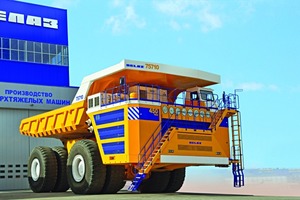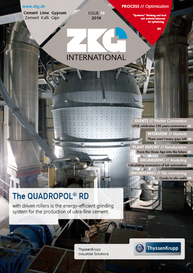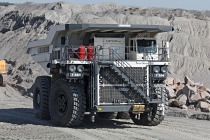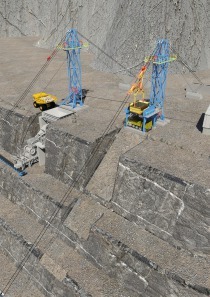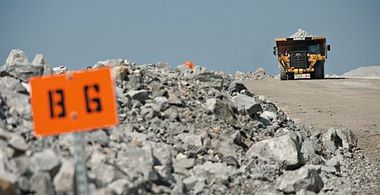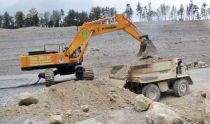The titans of open-pit mines
Again and again, the size of the excavator bucket has driven the development of the haul truck, and in turn the size of the pit determines the development of the excavator bucket. For economic reasons, it can be assumed that it takes three to a maximum of four loads from the excavator to fill a haul truck. That makes sense and saves time. In the meanwhile, however, the largest excavator buckets have a capacity of 135 tons*. This means that it is again time to come up with suitable trucks – like the Russian BelAZ-75710.
The dimensions alone are enough to impress: at 20.6 m it is considerably longer than competitors, though it has nearly the same profile with a height of 8.16 m and a width of 9.87 m. As such, it can be easily integrated into existing mine infrastructure. Empty, the colossus weighs 360 t, charged 860 t. Two 16-cylinder diesel motors with a power rating of 1715 kW each, drive two generators which transfer the electrical energy via converters to four traction motors.
For more than 25 years, Siemens has been developing diesel-electric AC drives for haul trucks. The initial prototypes based on GTO technology were developed in 1998 for Hitachi and Liebherr. With the implementation of the water-cooled IGBT in 2005, a truck drive system could be developed capable of transporting between 240 and 400 tons.
“When BelAZ approached us to equip a haul truck with a loading capacity of 500 tons, our first impulse was to simply double the drive system of a 240-ton truck,” says Dr. Joy Mazumdar, Business Manager for Mining Trucks at Siemens in Atlanta/USA. “That seemed like a fairly straightforward solution, but the amount of real estate on the truck is limited. We needed to fit more power into a finite space.”
That’s why Siemens engineers started with a 400-ton drive system and optimized it for a 500-ton drive. For this, the power electronics to control the IGBT and the related software had to be newly developed. For the grid box, Siemens modified the 400-ton system for 500 tons, and the cooling system is similar to the 240-ton system, placed on two separate axes. The Siemens AC haul truck platform is a 1800-volt DC link. The rated voltage is 1300 to 1400 volts. The four newly developed inverters (one for each wheel) were IGBTs rated at 1500 amps, 3300 volts; the traditional version was 1200 amps, 3300 volts.
“The increased amperage made it possible to use the same inverter skid, but allowed more current for the increased torque,” adds Mazumdar. There were several modifications to the electrical cabinet, since two alternators required more space. There are also two field exciters and extra rectifiers, but all of the additional components could fit into the existing skid. Siemens uses electrical retarding on all of its trucks with IGBT choppers.
The grid box is similar to a 400-ton system, but it had to be extended to 24 resistors for modularity; earlier versions have 20. The traction control system SiBAS coordinates the four wheels, two alternators and two engines. It has to have mine-grade robustness and at the same time be operable in “limp” mode if an alternator or engine goes down.
For transaction motors, Siemens uses four motors from the 240-ton concept. These are installed directly behind each wheel hub on the axes and they are each responsible for driving a pair of wheels. The transaction motors are driven by newly developed, higher-performance converters. Thanks to this new addition, a fully independent supply and control of all wheel pairs is possible. With the separately adjustable speed, the vehicle can automatically increase the speed of its outer wheels in curves and lower the speed of the inner wheels (slip/slide control). This protects the extremely expensive tires from unnecessary wear and ensures directional stability by providing the necessary driving force to the individual sets of wheels.
The new 500-ton BelAZ-75710 is expected to be able to travel up a 10 % grade with 2 % rolling resistance at a speed of 11 km/h. During retard, it could safely travel downhill at 30 km/h. Short braking time requires 6 MW regular braking 5.3 MW.
Siemens has successfully developed a system for BelAZ that allows a 500-ton truck to be powered on the same footprint as a 360-ton truck, which simplifies the design of the truck’s power deck layout.
The first trucks in the series are currently undergoing factory testing and will be delivered to an open-pit coal mine in Siberia’s Kuzbaz region. According to BelAZ’s calculations, the new haul truck is 25 % more productive than the best haul trucks currently available.
//www.siemens.com" target="_blank" >www.siemens.com:www.siemens.com

